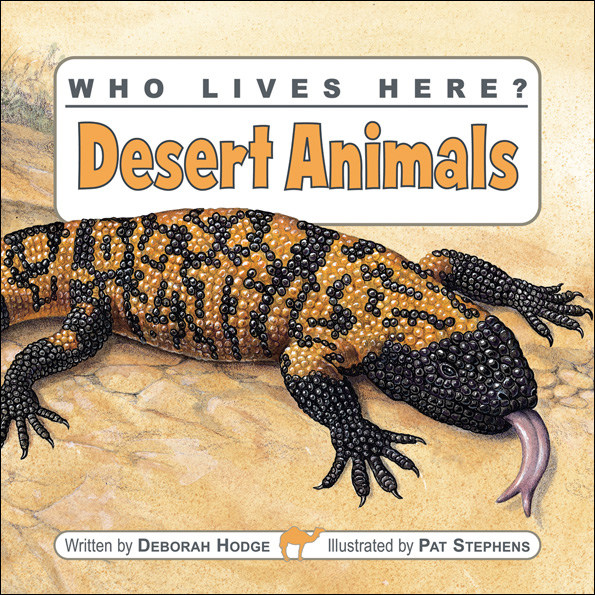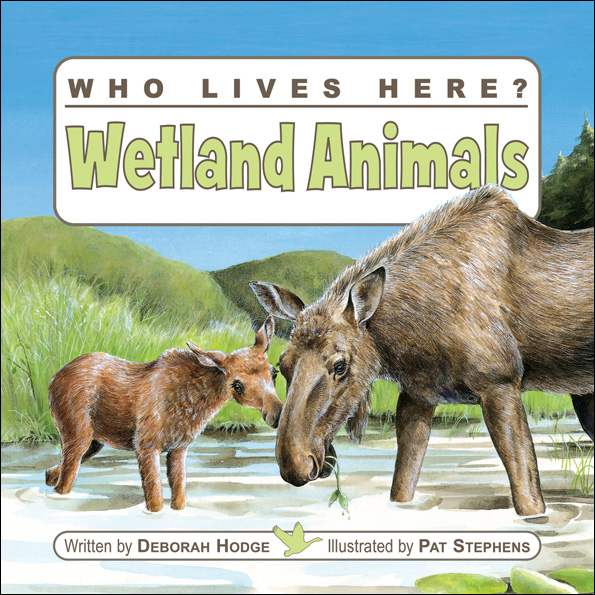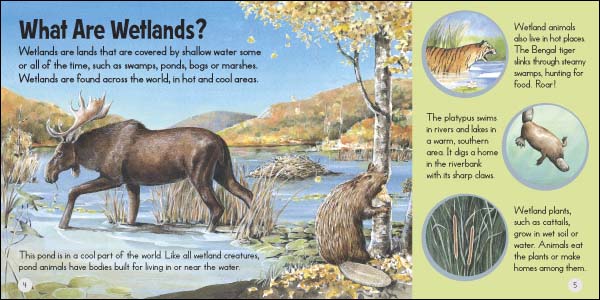The Who Lives Here? series, written by Deborah Hodge and illustrated by Pat Stephens, examines animals in their natural environments and explains how those animals are uniquely adapted to their habitats. The books are organized by habitat, and include titles on Desert Animals, Polar Animals, Rain Forest Animals and Wetland Animals.
Both Desert Animals and Wetland Animals open with a Table of Contents that begins with a page that defines that habitat (What is a Desert? and What is a Wetland?) and ends with a page containing animals words (pictorial index) and information for parents and teachers. In between are 9 double-page spreads, each introducing a different animal.
The opening pages that ask the question “What is a __?” provide a good basic introduction to the habitat. Here is how the What is a Desert? page begins.
A desert is a very dry place. Almost no rain falls here. Most deserts are found in hot parts of the world, under a blazing sun. Deserts can be sandy or rocky. Only a few are cold.
Deserts are home to many interesting animals. Their bodies are built for living in hot places, where this is very little water to drink.
The facing page briefly describes the growth that occurs when rain does fall, a bit about the plants, and the need for animals to find shade.
Here is an image of similar pages from the Wetland Animals book.
Once the background information has been covered, these books are all about the animals. Each one covers an amazing array. In Desert Animals readers meet the following animals:
- Fennec Fox
- Elf Owl
- Sidewinder
- Addax
- Sand Cat
- Scorpion
- Bactrian Camel
- Gila Monster
- Roadrunner
In Wetland Animals readers meet these animals:
- Hippopotamus
- Mallard Duck
- Capybara
- Bullfrog
- Crocodile
- Beaver
- Flamingo
- Anaconda
- Moose
Each set of animal pages includes a description of the animal and a sidebar with facts about the animal and itsadaptations, as well as an illustration that covers a full one and a third of the double-page spread. Here is an example.
Fennec Fox
(Main Spread, p.6)
The fennec fox lives near desert sand hills, called dunes. These furry foxes are the size of small dogs.Tiny fox pups are born in an underground den. The mother cares for her babies while the father hunts for food.
(Sidebar, p.7)
The fox digs a hole in the sand called a burrow. It hides here during the heat of the day. Whew!A fox hunts in the cool desert night. It pounces on its prey — the jerboas and other small animals it eats.
Sharp hearing helps a fox find its prey. The big ears also give off heat to keep the fox cool.
Each of these animal entries is packed with information. The text is easy to read and the illustrations in the sidebar support the text by providing close-up views of the adaptations described. The animal words section on the last page of each book provides a search-and-find opportunity for readers. Six close-up views of a body part are accompanied by a name, page number, and the question “Can you find pictures of these body parts in the book?” The idea here is for students to revisit the pages and think about how the body part helps the animal adapt to its environment.
The final section on the last page of the book provides background information about the environment. Though short, this is very important. Nowhere in the text does the author explain that the animals described come from deserts or wetlands around the world. It would be very easy for a reader to make the assumption that all these animals actually live in the same place. However, hippos and capybaras don’t even live on the same continent. The same is true for Bactrian camels and gila monsters. Teachers and parents reading this with young children will need to make it clear that while the animals depicted live in the same type of environment, they do not necessarily live in the same part of the world. This is precisely the information provided in this final section.
Despite this one concern, I found the books to be useful resources for studying how a variety of animals adapt to their environments. The accessibility of the language and detailed illustrations will make them appealing to readers as well.
Books: Desert Animals and Wetland Animals
Author: Deborah Hodge
Illustrator: Pat Stephens
Publisher: Kids Can Press
Publication Date: 2008
Pages: 24 pages
Grades: K-3
Source of Book: Review copies received from Raab Associates.
This post was written for Nonfiction Monday. Head on over to Anastasia Suen's blog and check out all the great posts highlighting nonfiction this week.



